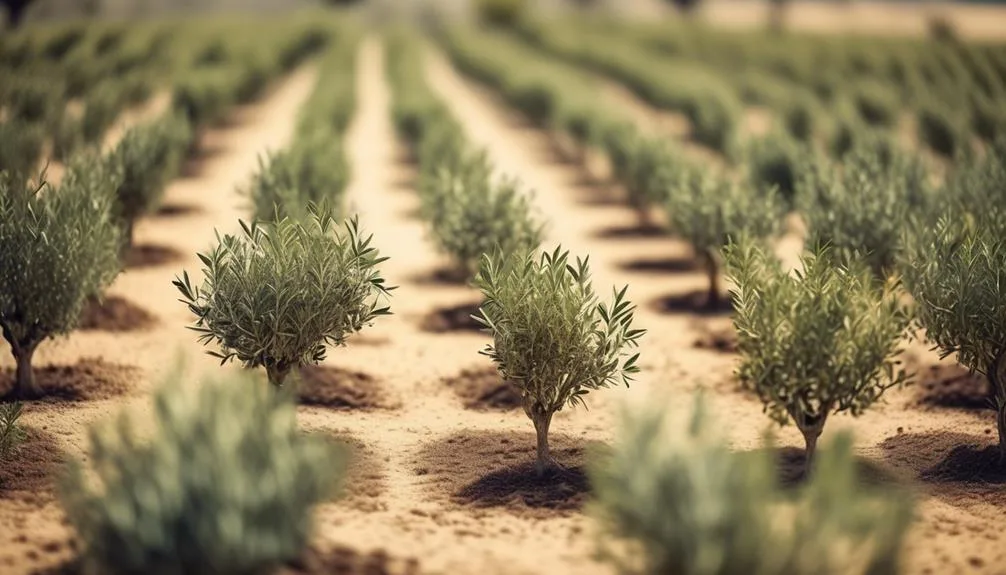Choosing the right olive tree variety is crucial for its success. Consider your climate, how you plan to use the olives, the tree's size and growth habits, disease resistance, and fruit characteristics.
Whether you're new to gardening or an experienced olive enthusiast, making an informed choice is important. Let's explore the key factors to consider when selecting the perfect olive tree variety for your needs.
Key Takeaways
- Consider the climate and location factors such as soil type, sun exposure, and the need for soil amendments and pruning nearby trees to select the right olive tree variety for your specific environment.
- Take into account the intended use of the olive tree, whether it is for ornamental landscaping, culinary applications, or dual purposes, and choose a variety accordingly.
- Evaluate the tree size and growth habit to ensure it fits well within your landscape, considering compact and slow-growing varieties for smaller gardens or containers, and varieties with significant heights and spreads for larger spaces.
- Assess disease resistance ratings, rootstock compatibility, and yield potential when selecting an olive tree variety, and consult with experts for insights into disease-resistant varieties to ensure the health and longevity of your tree.
Consider Your Climate and Location
When choosing the right olive tree variety, it's crucial to consider your climate and location to ensure the tree thrives in its environment.
Firstly, look at your soil type. Olive trees prefer well-draining, sandy soil with a pH level between 5.5 and 7.5. If your soil doesn't meet these requirements, amendments may be necessary to create a suitable environment for the tree.
Additionally, sun exposure is vital. Olive trees thrive in full sun, so ensure they receive at least six hours of direct sunlight daily. If your location doesn't provide this, consider pruning nearby trees to allow more sunlight in.
Understanding your climate and location, including soil type and sun exposure, will help you select the right olive tree variety for a thriving, fruitful tree in your specific environment.
Determine Your Intended Use
Considering your climate and location, you can now determine the right olive tree variety based on your intended use, ensuring a fruitful and thriving tree in your specific environment. Here are some considerations to help you make the right choice:
- Ornamental Landscaping: If you primarily want an olive tree for its aesthetic appeal, look for varieties with attractive silver-green foliage and a graceful, compact growth habit.
- Culinary Applications: For those interested in harvesting olives for culinary purposes, seek out varieties known for their flavorful fruit and high oil content, such as Arbequina or Koroneiki.
- Dual Purpose: Some olive tree varieties are versatile, suitable for both ornamental landscaping and olive production. These can be a great choice for those looking to enjoy both the visual and practical benefits of olive trees in their landscape.
- Climate Adaptability: Consider the adaptability of the variety to your specific climate and microclimate, ensuring it will thrive and produce well in your location.
Assess Tree Size and Growth Habit
As you select the right olive tree variety for your specific needs, it's essential to assess the tree's size and growth habit to ensure it will fit well within your landscape and thrive in your environment. Consider the ultimate height and spread of the tree, as well as its growth rate.
Some olive tree varieties are more compact and slow-growing, making them suitable for smaller gardens or containers, while others can reach significant heights and spreads. Understanding the growth habit will also help you plan for any necessary pruning techniques to maintain the desired shape and size of the tree.
Additionally, different olive tree varieties have varying soil requirements, so it's crucial to match the tree's growth habit with the soil conditions in your area to promote healthy growth and fruit production.
Evaluate Disease Resistance
To ensure the health and longevity of your olive tree, it's crucial to assess its disease resistance when selecting the right variety for your garden or landscape.
When evaluating disease resistance, consider the following:
- Disease Resistance Ratings: Look for olive tree varieties with high disease resistance ratings to ensure they can withstand common diseases and pests.
- Evaluate Rootstock Compatibility: Ensure the selected variety is compatible with the rootstock to maximize disease resistance and overall tree health.
- Compare Yield Potential: Some varieties may offer better disease resistance while still providing high yield potential, making them a favorable choice for your garden or landscape.
- Consult with Experts: Seek advice from local nurseries or agricultural experts to gain insights into disease-resistant olive tree varieties suitable for your specific region.
Research Flavor and Fruit Characteristics
Explore the unique flavors and fruit characteristics of different olive tree varieties to find the perfect match for your garden or landscape.
Consider the flavor profiles of olives from each variety, ranging from mild and buttery to fruity and peppery.
Some varieties are renowned for their high fruit production, which is an essential factor to consider if you're interested in harvesting olives for culinary use or oil production.
Additionally, delve into the cultural significance and historical uses of different olive varieties. Some may have been traditionally used for table olives, while others were primarily cultivated for their oil.
Understanding these aspects can help you choose an olive tree variety that aligns with your preferences and intended use.
Ultimately, researching flavor and fruit characteristics will guide you towards selecting the ideal olive tree variety for your specific needs.
Conclusion
Selecting the right olive tree variety is crucial for a successful harvest. Consider your climate, intended use, tree size, disease resistance, and fruit characteristics when making your decision.
With the right variety, you can enjoy a bountiful harvest of delicious olives for years to come.
Happy planting!

